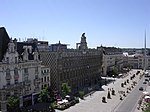Siege of Valenciennes (1793)
1793 in France1793 in the Habsburg monarchy1793 in the Holy Roman EmpireBattles in Hauts-de-FranceConflicts in 1793 ... and 5 more
French conquest of the Austrian NetherlandsSieges involving FranceSieges involving Great BritainSieges of the War of the First CoalitionValenciennes

The siege of Valenciennes took place between 13 June and 28 July 1793, during the Flanders Campaign of the War of the First Coalition. The French garrison under Jean Henri Becays Ferrand was blockaded by part of the army of Prince Josias of Saxe-Coburg-Saalfeld, commanded by the Prince Frederick, Duke of York and Albany. Valenciennes fell on 28 July, resulting in an Allied victory.
Excerpt from the Wikipedia article Siege of Valenciennes (1793) (License: CC BY-SA 3.0, Authors, Images).Siege of Valenciennes (1793)
Place d'Armes, Valenciennes
Geographical coordinates (GPS) Address Nearby Places Show on map
Geographical coordinates (GPS)
| Latitude | Longitude |
|---|---|
| N 50.3581 ° | E 3.5233 ° |
Address
Place d'Armes
Place d'Armes
59300 Valenciennes, Faubourg de Paris
Hauts-de-France, France
Open on Google Maps









